
|
Zuiko Digital 7-14 mm F/4 |

|
My other articles related to the |
|
This is a user report of the premium wide-angle zoom lens for the Four Thirds system cameras (the Olympus E-Series SLRs). |
|
With this lens we are getting into the premium glass area, referred to by Olympus as Super Pro (What next? "Super Ultra Pro Plus?"). At the going U.S. price of about $1500 (with rebates available occasionally), this is a serious investment. Still, after talking to some of my pro photographer friends, and after checking the wide-angle offerings for other DSLR systems (including Canon and Nikon), I realized that the 7-14 mm ZD may be, on fact, one of the best bargains available. Let us start from the image angle. The shortest, 7 mm focal length is, in terms of 35-mm film, equivalent to 14 mm, i.e., it provides the same 114° image angle, measured diagonally. For a rectilinear lens, the image angle can be computed as α = 2×atan(d/2F), where F is the focal length, and d — the frame diagonal. This diagonal is 21.6 mm for the Four Thirds frame, 28.5 mm for the APS-C (Canon) one, and 43.3 mm for the 24×36 mm film. Surprisingly, no other maker provides such a wide lens (zoom or not, non-fisheye) in their lineup for cameras with sensors smaller than 24×36 mm (read: current Nikon and Canon pro models, priced well above what you or I can afford). I've met two people, one using a Canon system and one Nikon (both very happy with their choices), who bought an E-300 or E-500 just to be able to use the 7-14 mm ZD lens. Here is a table comparing the 7-14 mm ZD with the widest (non-fisheye) offerings for various APS-C camera lines: | ||||||||||||||||||||||||||||||||||||||||||||||||||||||||
| ||||||||||||||||||||||||||||||||||||||||||||||||||||||||
|
In some wide-angle applications, with images cropped to a more elongated format, it is the horizontal image angle what counts most; cameras with the 3:2 aspect ratio (APS-C) perform then slightly better than their diagonal image angle would indicate. To account for that, I've added a column with the horizontal image angle; still, this does not significantly affect the comparison. On the other hand, most of the standard print sizes (with the notable exception of the smallest one, 4×6" or 10×15 cm) have aspect ratios closer to 4:3, so that some of the view angle will be lost on 3:2 cameras. Note: Sigma lens EFL and angular coverage are computed here for Sigma SLR cameras. Now that we know what makes the 7-14 mm ZD so unique, we can move one to a more detailed and systematic discussion of this lens. First impressions My first impression after taking the lens out of the box was its size and weight. It may not look so big alone (picture below left), but when mounted on the E-510, its bulk really shows. Then you notice that the front surface is very convex, almost a hemisphere, in spite of the element itself being a concave lens (i.e., thinner in the center than around the perimeter). This shape, similar to the one used in fisheye lenses, suggests some optical heavy lifting inside. | ||||||||||||||||||||||||||||||||||||||||||||||||||||||||
|
The lens bulge makes it impossible to use any filters; the tulip-shaped hood is permanently affixed to the lens rim. This makes sense: the hood also protects the lens front from touching a hard surface which might scratch it. This, of course, works only if that surface is flat: the lens tip is only about three millimeters behind the foremost hood edge. Oh, well, complaining about this would not be reasonable; these are facts of life with super-wide lenses. This is also a reason for the unusual push-on lens cap, which goes on top of the hood. The cap is made of aluminum, and its inner rim is lined with a velvet-like surface, providing just enough friction to keep the cap affixed. Some of my Exakta lenses, made in the Fifties, have such caps, and they are still working. The make and finish are first class, similar to other mid- or upper-range lenses from Olympus. The distance scale is there, perhaps to satisfy some reviewers lamenting its absence on lenses not providing this feature; see below. Other controls will be also described further down. Surprisingly, the lens feels good on the E-510, and even better on the E-500. In the latter case, the body shape asymmetry makes it easier to support the camera body in the palm of your left hand, while using the fingers for zoom adjustment; this is not as subjective as it may seem. Specifications and what they mean Let me now go through the lens specs, adding my comments whenever I may consider them necessary, helpful, or entertaining.
|
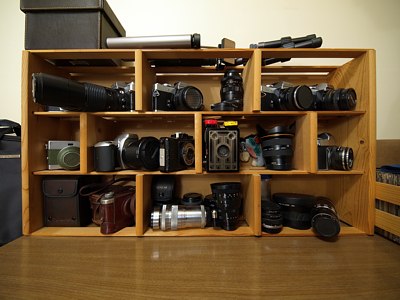
|
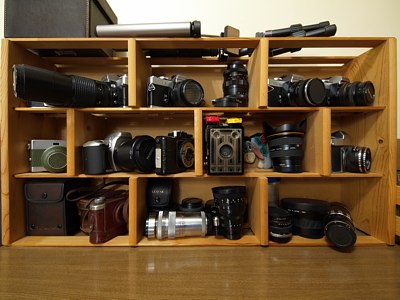
| |
| F = 7 mm (EFL = 14 mm) [full frame] | F = 8 mm (EFL = 16 mm) | |
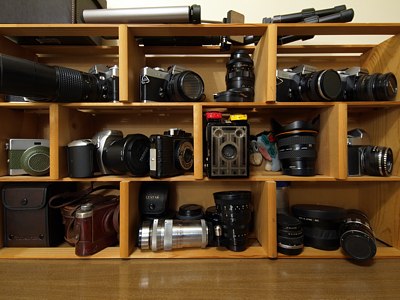
|
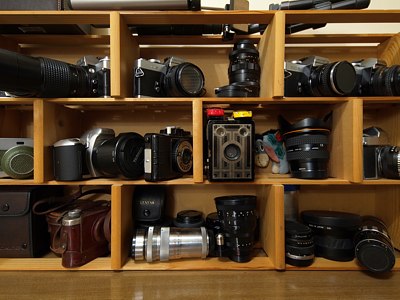
| |
| F = 9 mm (EFL = 18 mm) | F = 10 mm (EFL = 20 mm) | |
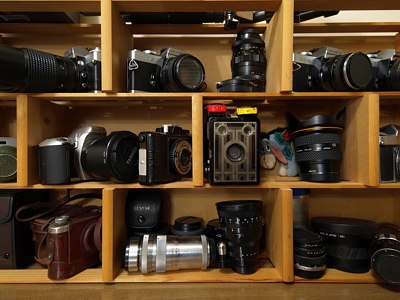
|
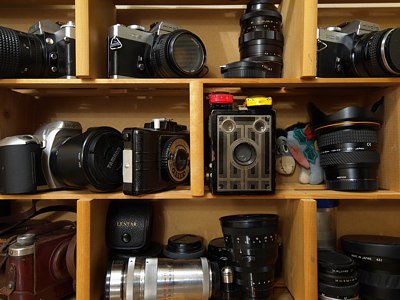
| |
| F = 11 mm (EFL = 22 mm) | F = 14 mm (EFL = 28 mm) |
|
The 8 and 9 mm samples can be used to compare this lens with offerings by other manufacturers listed in the table above, while the 11 mm one gives you a similar comparison with the 11-22 mm ZD lens I'm discussing elsewhere, and 14 mm — with the short end of the "standard" Zuiko Digital zooms. The full frame at 7 mm reveals very good sharpness (except, maybe, extreme corners) and some barrel distortion, easily excusable at this focal length. Interestingly, while the straight lines do not bend a lot, shapes are distorted (elongated radially), clearly visible in the lens caps — just check the green Zeiss Werra III (1960 or so) at the left, or the black lens (Schneider Tele-Xenar) at the bottom right. We'll come back to distortion later; here I just wanted to give you an idea about the angular coverage.
| |||
|
E-510, 7-14 mm F/4 ZD; aperture priority (0 EV): 1/20 s at F/4, ISO 1600, WB at 3000 K.
| 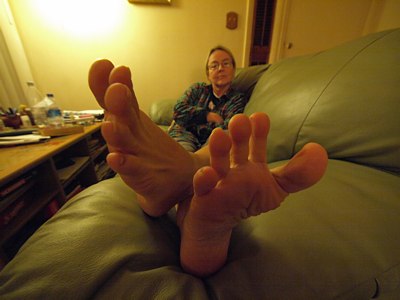
|
| |
|
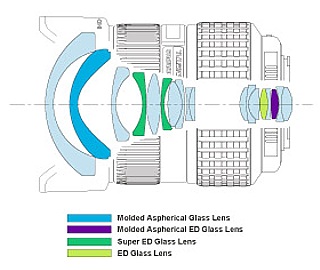 (Drawing by Olympus) |
| |
Make, feel, and operation This lens belongs to the premium Olympus line; it looks and feels accordingly, no surprises. The make and feel are like those of the 14-54 mm F/2.8-3.5 ZD zoom, which means very good. | |
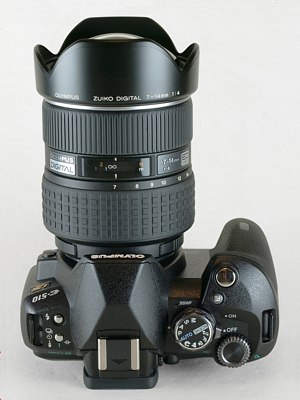
|
It sports a manual focus scale behind a transparent window, but this really serves just an ornamental purpose. The whole distance range from 25 cm to infinity is squeezed into a 20 mm scale (the sub-range above 1 m uses just about 3 mm), or 1/8 or so of the lens circumference. Even with the huge depth of field at these focal length, the scale serves no practical purpose. The manual focus ring is coupled electronically to the focusing motor. I do not like it too much; the tactile feedback is somewhat imprecise and the action feels delayed. This has been improved (ironically!) in the last generation of inexpensive Olympus "kit" zooms. This is not a real complaint: most of us will rarely, if ever, focus ZD lenses manually. The zoom ring has markings at 7, 8, 9, 10, 12, and 14 mm. The zoom action is smooth, if a bit stiffer than I would like it to be. |
|
As you would expect of a lens of this weight and size (not to mention the price), the bayonet mount is made of metal, probably stainless steel. In the field I've used this lens on the E-500 and E-510. Forget about one-handed shooting (which is a bad idea anyway); if you are using both hands, the camera/lens combination balances quite well, especially on the E-500. The autofocus action was as expected: no complaints, but nothing to brag about. This is still the "old" Olympus AF mechanism (the lens was released in 2005). It is possible that Olympus will introduce an updated version, using the new SWD focusing motor which will debut on their "new" 50-200 mm lens in early (?) 2008. From where I stand, this is a secondary issue. The unprotected and protruding front element requires some attention, so that it is not scratched or smudged by contact with your hands, bag, or the environment. You may also have to revise your lens-changing habit, always putting the lens cap on before the operation. Generally, I found the lens to be very enjoyable to use, finding myself using the 10-14 mm range for most of the interior shots, occasionally zooming out all the way to 7 mm. The wide end may be used to deliver some impressive scenics (or urban architecture) shots; unfortunately, we have a stretch of rainy weather in Maryland now, so I mostly stay inside. Performance: the MTF data All "lens tests" we can see published on the Web are not really lens test; they measure the joint resolution defined by the lens, camera vibration, AF system, image sensor, and raw-to-RGB conversion. The only source measuring the optical performance of the lens itself is the Popular Photography, and for that alone I'm apt to forgive them all stupidities they sometimes write about digital cameras. Unfortunately, Popular Photography never reviewed the 7-14 mm ZD, so the only source of MTF resolution data are the graphs provided by Olympus, and reproduced here. | |
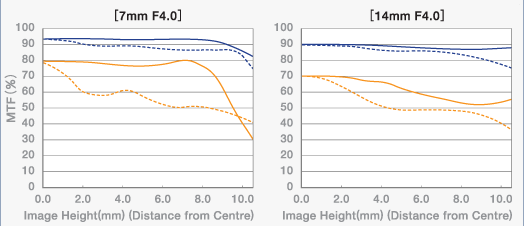
|
|
Image © by Olympus Corporation |
|
The left graph is for 7 mm, the right one — 14 mm. Blue lines correspond to a frequency of 10 LP/mm (this can be loosely interpreted as a measure of contrast), while red ones — 30 LP/mm (sharpness). Then, solid lines are for sagital, and dotted for tangential patterns. The 30 LP/mm graphs show that at 7 mm the lens performs better than at 14 mm; this was to be expected in a design most probably optimized at the widest angles. The solid value of around 80% holds all the way to 8.5 mm from the center, i.e., covers the whole frame width. There is a drop-off beyond that, denoting less sharpness in the corners, consistent with my casual observations. Compared to another wide-angle zoom from Olympus, the 11-22 mm ZD, the wider lens promises a higher resolution (with both wide open, both at the wide end); at the same focal length of 14 mm I would expect the 11-22 to perform a bit better. Remember that this is vendor's data, subject to any deviations and inconsistencies in the manufacturing process, but Olympus (similarly to other established brands) has a good track record here, so I wouldn't expect any unpleasant surprises. Visual scrutiny of two hundred or so pictures I've shot with this lens seems to confirm what MTF curves say. More on that when we discuss the samples shown. Distortion Wide-angle lenses generally suffer from a problem of image magnification changing with the distance from the axis. This leads to barrel- or cushion-like distortion, especially visible in long lines, parallel and near to the image edges. The shorter the focal length, the more difficult is this effect to avoid. In fisheye lenses, designers give up on trying to correct the distortion, focusing on other optical flaws instead. The 7-14 ZD, however, is a rectilinear lens, promising to keep straight lines straight; let us see how it succeeds in this department. Here is a series of image fragments at the focal length of 7, 8, 9, 10, and 14 mm, cropped to the area near the upper edge of each frame; the samples are reduced in size, but cover the full frame width. Each caption contains the distortion value as measured from the image. In the first version of this article I've been using the "old TV" definition for distortion values; now changed to the SMIA standard, which is the same one as used by Imatest and, I believe, Popular Photography. All it takes is doubling the values, so why not... |
|
| |
| 7 mm: distortion -2.6% | |
|
| |
| 8 mm: distortion -1.8% | |
|
| |
| 9 mm: distortion -0.8% | |
|
| |
| 10 mm: distortion -0.2%% | |
|
| |
| 14 mm: distortion +0.8% |
|
While the 2.6% I've measured at F = 7 mm can seem quite large, it is, in fact, moderate or low for this focal length. Between 9 and 14 mm the distortion changes from 0.8% barrel (negative) to 0.8% pincushion (positive), and these are very good values. At 10 mm (my favorite EFL of 20 mm!), the value of -0.2% is just outstanding; compare it to 1.5% at 11 mm for the 11-22 mm ZD lens. Samples: Crofton lake This is my regular sample subject, right in front of my home. The pictures were taken early December. All pictures in this section were shot with an E-510 and saved as out-of-camera HQ (1:4) JPEGs, in Vivid Picture mode, with both contrast sharpness to V-1 (even if usually I prefer N-1 or so); no saturation adjustment. Noise filtering was set to Off, which is my general preference for this camera, and makes even more sense in lens evaluation. |
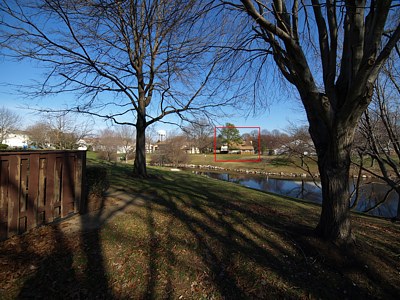
|
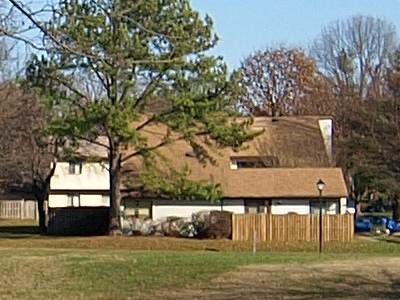
| |
| E-510, 7-14 mm F/4 ZD at 7 mm; aperture priority (-0.3 EV): 1/800 s at F/4, ISO 100. [Full frame] | ||
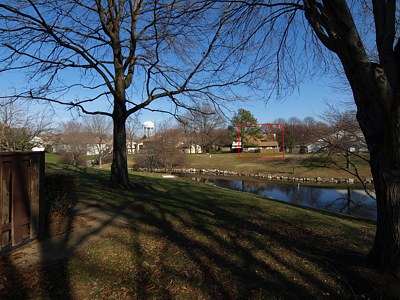
|
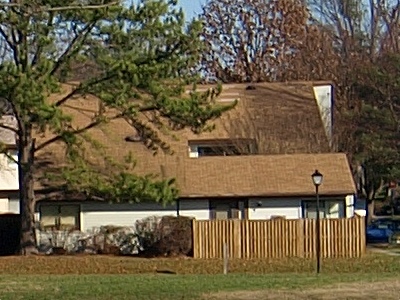
| |
| E-510, 7-14 mm F/4 ZD at 10 mm; aperture priority (-0.3 EV): 1/1000 s at F/4, ISO 100. [Full frame] | ||
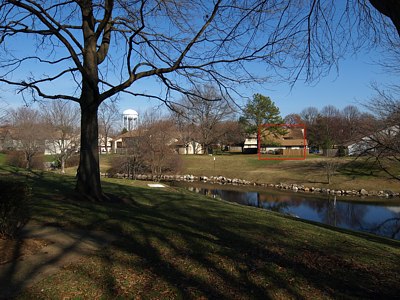
|
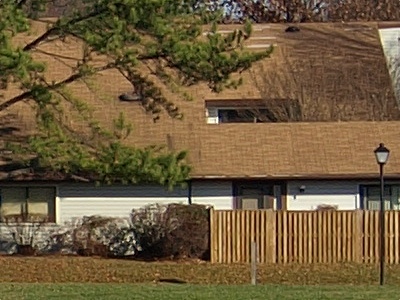
| |
| E-510, 7-14 mm F/4 ZD at 14 mm; aperture priority (-0.3 EV): 1/1000 s at F/4, ISO 100. [Full frame] | ||
|
Links to full, original out-of-camera JPEGs are given in captions, in case you would like to check how well does the lens do in the corners — and, indeed, it does! The detail is very good there. More, note that there is no visible chromatic aberration (purple/green fringing) in the far-out branches, although I was able to see some of this effect in other samples, shown later. You can also see that the V-1 (Vivid minus one) setting still provides way too much sharpening (or rather sharpening artifacts), and that I'm having problems with the highlights on the water tower; perhaps -0.7 EV would be better here. All this together, the first samples made me quite impressed: the lens, even wide open, seems to do optically as well as (or perhaps better than) the 14-54 mm "pro" standard zoom, in spite of a much more difficult focal length range. Samples: office park First, an example of the exaggerated perspective you an get at 7mm. I wasn't able to find a subject with some inwards-leading lines, enhancing the effect, but the following image may give you some idea. Again, samples in this section were shot (or rather converted) in the Vivid Picture mode, with sharpness and contrast one notch down; 1:4 JPEGs, noise filter off. |
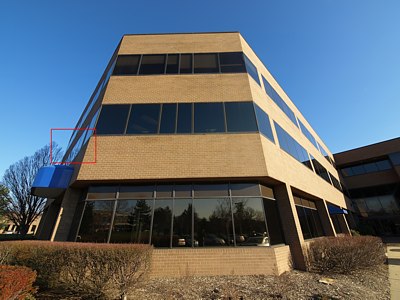
|
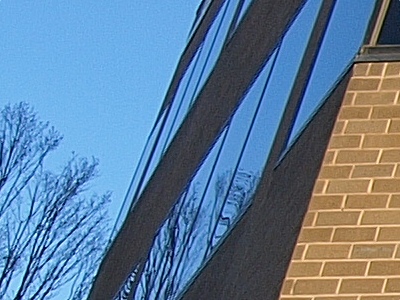
| |
| E-510, 7-14 mm F/4 ZD at 7 mm; aperture priority (0 EV): 1/200 s at F/7.1, ISO 100. | ||
|
I think the lens performs best between F/5.6 and F/8; this explains why this sample is so impressive. Taking this picture I really had to watch for flare effects, unavoidable at this image angle. To check the lens in extreme corners, I've got these shots from the same area: |
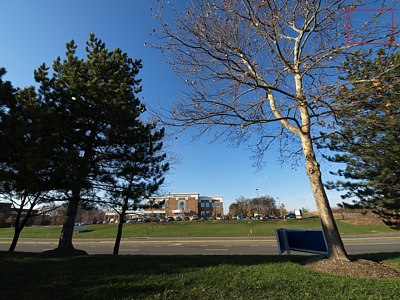
|
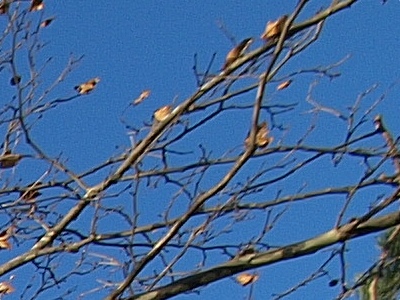
| |
| E-510, 7-14 mm F/4 ZD at 7 mm; aperture priority (0 EV): 1/250 s at F/7.1, ISO 100. | ||
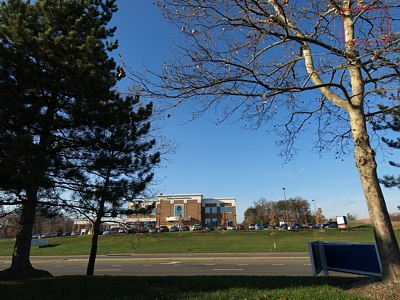
|
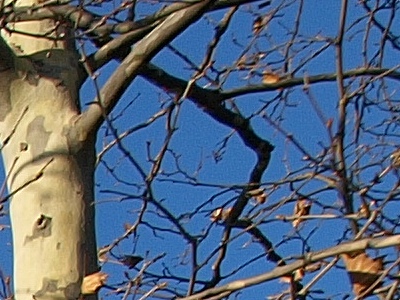
| |
| E-510, 7-14 mm F/4 ZD at 10 mm; aperture priority (0 EV): 1/250 s at F/7.1, ISO 100. | ||

|
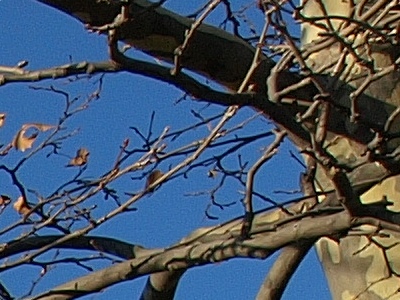
| |
| E-510, 7-14 mm F/4 ZD at 14 mm; aperture priority (0 EV): 1/320 s at F/7.1, ISO 100. | ||
|
Mind it, this is an ultra-wide zoom, and we are looking at the very corners. 'Nuff said. Chromatic aberration Note that we were still not able to see any noticeable chromatic aberration. This is just not right; every lens will show some. To prove it, I took this one on a quick walk under an overcast sky, and here it is. |
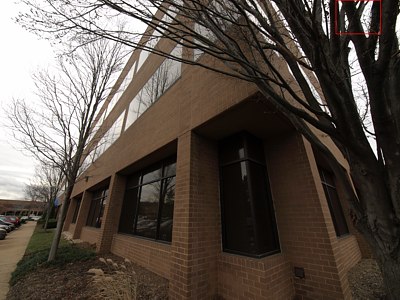
|
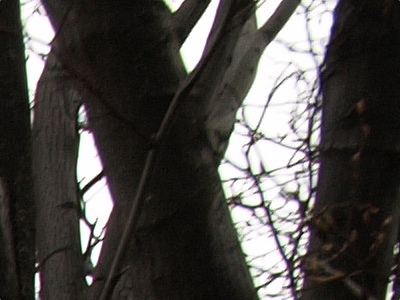
| |
| E-510, 7-14 mm F/4 ZD at 7 mm; aperture priority (0 EV): 1/100 s at F/7.1, ISO 100. WB at 6000°K (cloudy), Natural Picture mode; sharpness and contrast at N-2. 1:4 JPEG, noise filter off. | ||
|
So OK, here it is: a purple fringe outwards of bright areas, a green one inwards (radially). Still, the chromatic aberration is very well controlled in this lens; if you disagree, tough: try to find any other lens doing a job that good, at any price, and at an EFL of 20, not even 14 mm. Good luck; I take this one. Samples: my license plate Having put the CA issue to sleep, a few more samples covering the whole range of focal lengths, this time in diffused light. Yes, I know, this car needs a wash, but this is December! For these samples, the camera was using my default setup: Natural Picture Mode with sharpness and contrast at -2, 1:4 JPEGs. White balance was set at 6000°K (cloudy). |
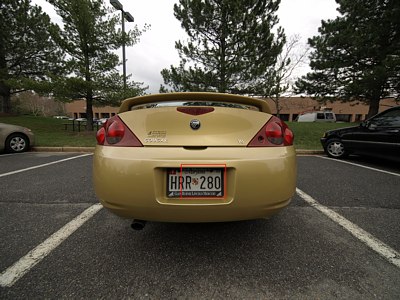
|
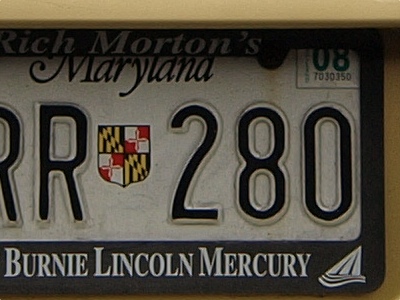
| |
| E-510, 7-14 mm F/4 ZD at 7 mm; aperture priority (0 EV): 1/320 s at F/4, ISO 100. | ||
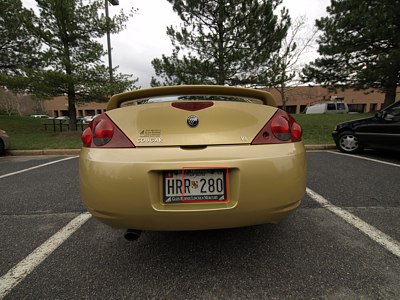
|
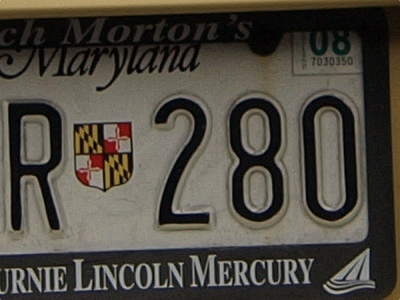
| |
| E-510, 7-14 mm F/4 ZD at 8 mm; aperture priority (0 EV): 1/320 s at F/4, ISO 100. | ||
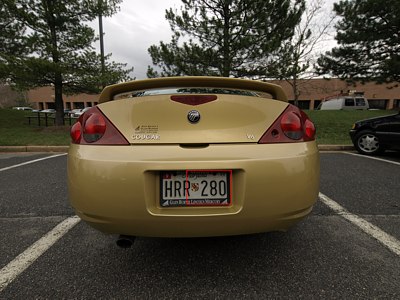
|
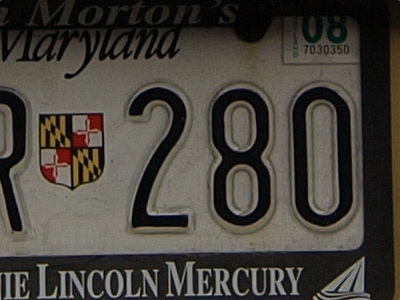
| |
| E-510, 7-14 mm F/4 ZD at 9 mm; aperture priority (0 EV): 1/400 s at F/4, ISO 100. | ||
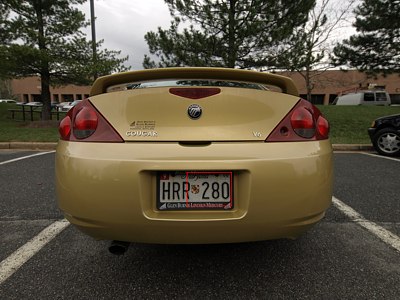
|
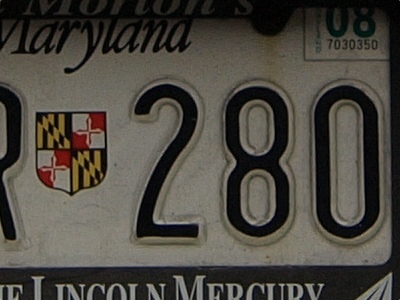
| |
| E-510, 7-14 mm F/4 ZD at 10 mm; aperture priority (0 EV): 1/400 s at F/4, ISO 100. | ||
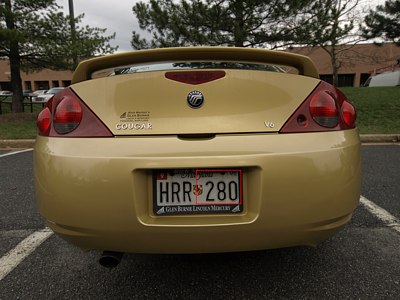
|
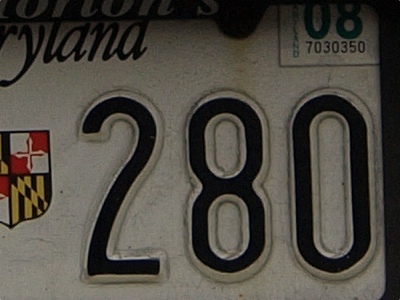
| |
| E-510, 7-14 mm F/4 ZD at 12 mm; aperture priority (0 EV): 1/320 s at F/4, ISO 100. | ||
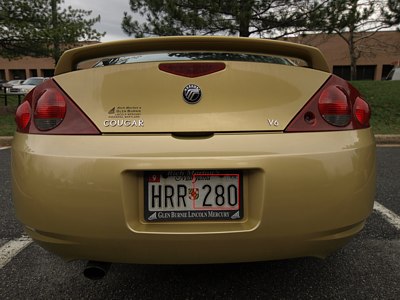
|
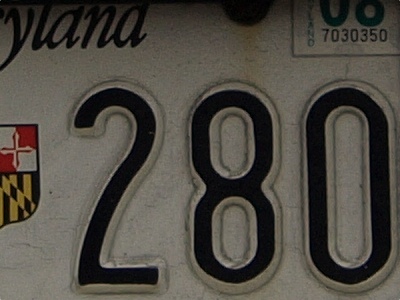
| |
| E-510, 7-14 mm F/4 ZD at 14 mm; aperture priority (0 EV): 1/400 s at F/4, ISO 100. | ||
|
And now back to 7 mm, coming closer, to achieve the same coverage as at 14 mm above (even if exposure compensation and aperture are different), just to show the difference in perspective... |
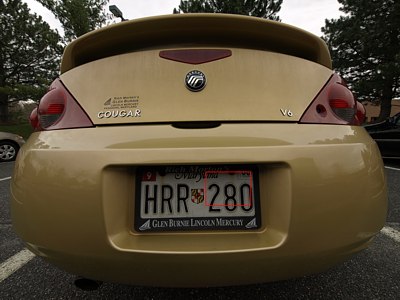
|
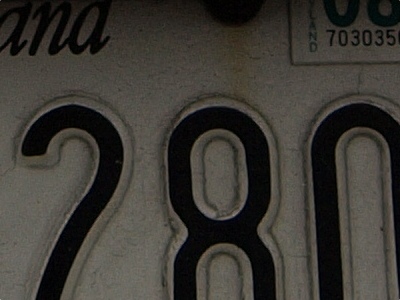
| |
| E-510, 7-14 mm F/4 ZD at 7 mm; aperture priority (0 EV): 1/320 s at F/4, ISO 100. | ||
|
Actually, my license plate samples did not bring anything new to the show, just confirming how optically good this lens is. Oh, boy. Samples: indoors Unfortunately, during my two weeks with this champion I didn't have an opportunity to try it indoors on something non-trivial. For the time being, these two images must do. They were both shot at 7 mm, to show the wide-angle capabilities of this lens rather than its quality. (Both pictures were taken handheld, with image stabilization.) |
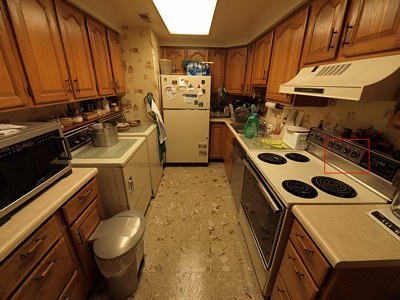
|
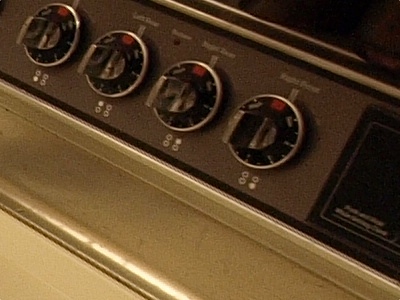
| |
| E-510, 7-14 mm F/4 ZD at 7 mm; aperture priority (0 EV): 1/25 s at F/5.6, ISO 400, Auto WB. Sharpness and contrast at N-2. | ||
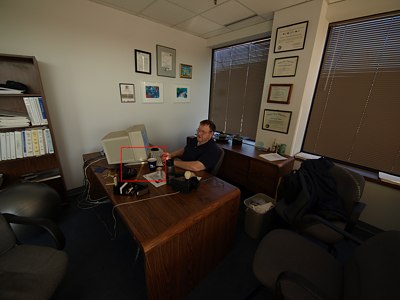
|
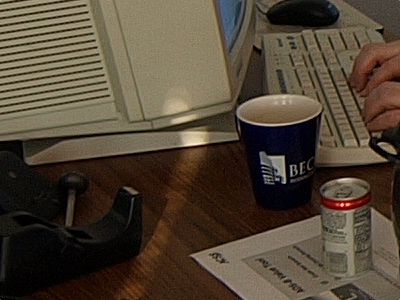
| |
| E-510, 7-14 mm F/4 ZD at 7 mm; aperture priority (-0.7 EV): 1/39 s at F/4, ISO 100, Auto WB. Sharpness and contrast at V-1. | ||
|
While these samples say more about the camera than about the lens itself, they illustrate the lens angular coverage quite well, I would think. The Bottom Line This is the second wide zoom I've been using this year, after the 11-22 mm F/2.8-3.5 ZD. While I liked that one quite a lot ("This is a very good, if not outstanding, lens", to quote myself), with this one I'm just plain thrilled. Big and heavy? Yes, but it starts from 7 mm! Expensive? Yes, but it starts from 7 mm! No filter options? Yes, but it starts from 7 mm! Optical quality? Yes... oops, wrong! The optical quality is outstanding, in spite of the exotic specs! Actually, resolution-wise this lens may be better than you or I need. OK, I can live with that... At these image angles, this may be not a lens for everyone. It requires cautious use (flare, composition) and cannot be used for any subject, but, when properly used, it repays you with great images, high resolution, and striking perspective with minimal, if any, distortion. It is also very sharp, and chromatic aberration is close to non-existent — better than in most lenses I've used, and that's in spite of the focal length! At the focal length of 9-10 mm (for me, the most usable wide angle), its performance is as good as I could ever wish. I bought this lens for a friend, and kept it for a couple of weeks before handing it over to him. After three days it became clear: I want one for myself, too. Interestingly, I didn't have this feeling about the 11-22 mm ZD, acquired on the same basis. This one just screams: buy me! The only other lens about which I felt this way was the 50 mm Macro ZD. That was not just a one-night stand: that lens still remains my favorite (and it sells at a price ridiculously low for what you get). The 7-14 ain't cheap, but it is worth every penny — if wide angle is what you need. Other information sources Taking into account the nature of this lens, it is not surprising that there isn't much information on it available on the Web. A notable exception is
|

|
My other articles related to the |
|
Olympus® is a registered trademark of Olympus Corporation.
This page is not sponsored or endorsed by Olympus (or anyone else) and presents solely the views of the author. |
| Home: wrotniak.net | Search this site | Change font size |
| Posted 2007/12/16; last updated 2017/06/21 | Copyright © 2007-2008 by J. Andrzej Wrotniak |